Universal Camouflage Pattern
The Universal Camouflage Pattern (UCP) is a digital military camouflage pattern formerly used by the United States Army in their Army Combat Uniform.[4][5] Technicians at Natick Soldier Systems Center attempted to devise a uniform pattern that would mask the wearer in all seasonal environments.[6] Laboratory and field tests from 2003 to 2004 showed a pattern named "All-Over-Brush" to provide the best concealment of the patterns tested.[6] All-Over-Brush was selected as the winner over ten other patterns,[7] It was observed at the time that the universal disadvantage of an all-in-one pattern meant compromise and lowered effectiveness in all environments versus a more effective coloration for each environment.[6] Further, the winning All-Over-Brush pattern was not in fact chosen as the final UCP.[6] Instead, U.S. Army leadership utilized pixellated images taken from Canadian CADPAT and US Marine Corps MARPAT, then recolored them based on three universal colors developed in the Army's 2002-2004 tests, to be called the UCP.[6] While the pixelated pattern of the UCP is similar to the MARPAT and CADPAT camouflage patterns used by the United States Marine Corps and the Canadian Armed Forces, its coloration differs significantly.[8][9] The final UCP was then adopted without field testing against other patterns.[6]
| Universal Camouflage pattern | |
|---|---|
.jpg.webp) A sample of the UCP pattern | |
| Type | Military camouflage pattern |
| Place of origin | United States |
| Service history | |
| In service | 2005–2019 (U.S. Army)[lower-alpha 1][lower-alpha 2] |
| Used by | State defense forces See Users for non-US users |
| Wars | (In U.S service): War in Afghanistan Iraq War (In Non-U.S service): Mexican drug war Insurgency in Northern Chad Second Nagorno-Karabakh War Syrian civil war Yemeni civil war Russian invasion of Ukraine |
| Production history | |
| Designed | 2004 |
| Produced | 2004–present |
| Variants | Universal Camouflage Pattern Delta (UCP–D)[3] |
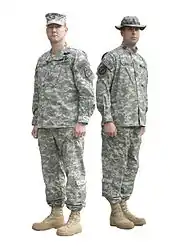
Soldiers serving in Iraq and Afghanistan questioned the effectiveness of the UCP in concealing them from enemy observation, and that the uniform was in fact endangering their missions and their lives.[6] In response, the US Army conducted several studies to find a modification or replacement for the standard issue pattern.[10] In July 2014, the Army announced that Operational Camouflage Pattern would replace all UCP-patterned ACU uniforms by the end of September 2019.[11][12][13][14] However, UCP does remain in service in limited capacities, such as on some cold weather overgear and older body armor.[1]
Selection

Initial patterns and colors
Three patterns were developed, called All Over Brush, Track, and Shadow/Line.[15] For each pattern, there were four color combinations, which corresponded to a specific type of terrain, however, all four patterns used tan as their base color.[15] The three remaining colors were green, brown, and black for the Woodland pattern, dark tan, khaki, and brown for the Desert pattern, light gray, medium gray, and black for the Urban pattern, and dark tan, light gray, and brown for the Desert/Urban pattern.[15]
Test sites
There were fifteen evaluations, which took place at Fort Benning, Fort Polk, Fort Irwin, Fort Lewis, and Yakima, Washington.[15] The camouflage patterns were then rated on their blending, brightness, contrast, and detection by U.S. Army soldiers, during the daytime, and also at night using night vision devices.
Elimination of patterns
Following testing, the Shadow Line pattern was eliminated, along with the urban and desert/urban patterns of All Over Brush. All four of the Track patterns were accepted along with All Over Brush's woodland and desert patterns.[15]
Phases II and III
The patterns were then modified and tested alongside a newly introduced "Contractor-Developed Mod" pattern, Scorpion, developed in conjunction with Crye Precision. Near infrared testing determined that black, medium gray, and medium tan were the only colors that gave acceptable performance.[15]
Phase IV (system level)
All four remaining patterns, desert Brush, Scorpion, Woodland Track, and Urban Track were then tested alongside each other in urban, woodland, and desert environments.
Results
The desert Brush design received the best overall mean daytime visual rating. Contractor developed pattern received highest rating in woodland environments, but low ratings in desert and urban environments. Urban Track was generally the 3rd or 4th worst performer at each site, but was the best performer in nighttime environments. Infrared testing showed negligible differences in the performance of the four patterns. Natick rated the patterns from best to worst as: Desert Brush, Woodland Track Mod, Contractor-Developed Mod (Scorpion), and Urban Track.[16]
Color selection
The color scheme of the UCP is composed of tan (officially named Desert Sand 500), gray (Urban Gray 501), and sage green (Foliage Green 502). The pattern is notable for its elimination of the color black.[17] Justification given for the omission of black was that black is a color not commonly found in nature.[18] Pure black viewed through night vision goggles can appear extremely dark and create an undesirable high-contrast image.
Controversy

The U.S. Army incorrectly reported to the media that the basis for the UCP was the Urban Track pattern, which had been modified through the removal of black from the pattern and pixelated. Pattern comparisons subsequently established that the information provided by the U.S. Army was incorrect, and that the pattern was simply a three-colored version of MARPAT, a derivative of the Canadian CADPAT scheme. No evidence has been presented by the U.S. Army that the new UCP pattern had undergone proper field testing.[6] In tests conducted by the Natick Soldier Systems Center, results indicated that three other patterns did significantly better than UCP in desert and woodland environments.[19]
Following building criticism of the poor effectiveness of the pattern in most terrains like the Afghan and Middle Eastern theatres of operations, the use of the pattern was discussed within the U.S. Congress. A bill passed by Congress in 2009 ordered the Department of Defense to "take immediate action to provide combat uniforms to personnel deployed to Afghanistan with a camouflage pattern that is suited to the environment of Afghanistan."[20] In the interim the Army conducted a brief in-country test of replacements for use in Afghanistan that included "UCP Delta", a variant of UCP that added coyote brown, and the commercial pattern MultiCam, which had been created by Crye Precision based on the Scorpion pattern from 2002. MultiCam was quickly selected and issued to all troops deployed to Afghanistan.
Replacement
In 2014, the United States Army announced the replacement of UCP.[21] On 31 July 2014, the Army formally announced that a modified version of the original Scorpion pattern, Scorpion W2, had been chosen as the new Operational Camouflage Pattern (OCP), which would begin being issued on uniforms in summer 2015. Authorization of UCP uniforms ended on 1 October 2019,[11][12][22] though still sees some limited usage on other gear such as some body armor and cold weather overgear.
As the Army began phasing out UCP, many state defense forces began adopting it as their uniform.[23][24]
Users

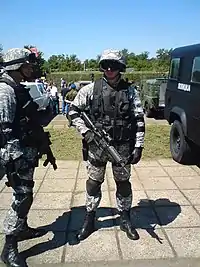
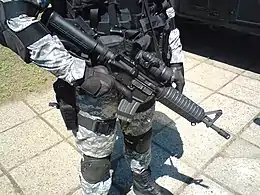
Current
 Argentina: Used by the Grupo Especial Uno.[25]
Argentina: Used by the Grupo Especial Uno.[25] Azerbaijan: Used by the Azeri Ministry of Interior's Kobra Special Group.[26]
Azerbaijan: Used by the Azeri Ministry of Interior's Kobra Special Group.[26].svg.png.webp) Bolivia: Regular UCP used by the Bolivian Police's UTARC and GICE units; dark UCP used by the UTOP.[27]
Bolivia: Regular UCP used by the Bolivian Police's UTARC and GICE units; dark UCP used by the UTOP.[27] Bosnia and Herzegovina
Bosnia and Herzegovina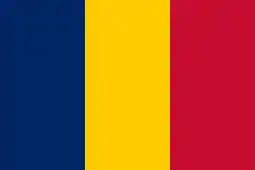 Chad: UCP clones used by some Chadian commando units and by Chadian Gendarmerie anti-poaching units.[28]
Chad: UCP clones used by some Chadian commando units and by Chadian Gendarmerie anti-poaching units.[28] Chile: Used by the Chilean Air Force as uniform for airmen.[29][30]
Chile: Used by the Chilean Air Force as uniform for airmen.[29][30] Cyprus: Used by Cypriot special forces.[31]
Cyprus: Used by Cypriot special forces.[31] Hungary: Used by Counter-Terrorism Center operators.[32]
Hungary: Used by Counter-Terrorism Center operators.[32] India: Used for urban operations only by MARCOS commandos and Paras.[33] The Indian Air Force adopted a similar pattern in 2022.[34]
India: Used for urban operations only by MARCOS commandos and Paras.[33] The Indian Air Force adopted a similar pattern in 2022.[34] Iran: UCP clones used by the Islamic Republic of Iran Navy Marine Command and some Basiji special operations forces.[35]
Iran: UCP clones used by the Islamic Republic of Iran Navy Marine Command and some Basiji special operations forces.[35] Kazakhstan: Used by almost all branches of the Kazakh ground forces. Their version of UCP is similar to UCP-D but with a light green inlay instead of a brown one. Called "KazTcifra" it makes not just an interesting blend for the wearer but also actually manages to fit the terrain well.[36]
Kazakhstan: Used by almost all branches of the Kazakh ground forces. Their version of UCP is similar to UCP-D but with a light green inlay instead of a brown one. Called "KazTcifra" it makes not just an interesting blend for the wearer but also actually manages to fit the terrain well.[36]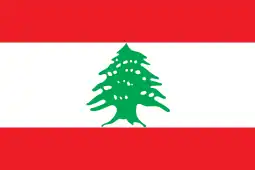 Lebanon: Lebanese Marine Commandos use both local copies and surplus UCP ACU uniforms from U.S. Army.
Lebanon: Lebanese Marine Commandos use both local copies and surplus UCP ACU uniforms from U.S. Army. Malaysia: Supplied and used by the Special Task and Rescue unit.[37]
Malaysia: Supplied and used by the Special Task and Rescue unit.[37] Mexico: Used by the Sinaloa State Police's Special Anti-Kidnapping Unit.[38]
Mexico: Used by the Sinaloa State Police's Special Anti-Kidnapping Unit.[38] Montenegro: Used by the Montenegrin Special Anti-Terrorist Unit.[39]
Montenegro: Used by the Montenegrin Special Anti-Terrorist Unit.[39] Moldova: Known to be used by operators of the Posebna Jedinica Policije.[40]
Moldova: Known to be used by operators of the Posebna Jedinica Policije.[40] North Macedonia: Used by the Rapid Deployment Unit.
North Macedonia: Used by the Rapid Deployment Unit. Paraguay: Used by Paraguayan National Police's Grupo Lince unit with dark colored palettes.[41]
Paraguay: Used by Paraguayan National Police's Grupo Lince unit with dark colored palettes.[41] Peru[30]
Peru[30] Saudi Arabia: Used by Royal Saudi Air Force personnel, which has a darker color palette.[42]
Saudi Arabia: Used by Royal Saudi Air Force personnel, which has a darker color palette.[42] Serbia: Used by the Serbian Special Anti–Terrorist Unit only in operations inside cities/towns with UCP-patterned BDUs.[43] Also used by the Gendarmery.[44]
Serbia: Used by the Serbian Special Anti–Terrorist Unit only in operations inside cities/towns with UCP-patterned BDUs.[43] Also used by the Gendarmery.[44] Ukraine: Used by some divisions of the Armed Forces of Ukraine from special forces to airborne units.[45]
Ukraine: Used by some divisions of the Armed Forces of Ukraine from special forces to airborne units.[45]
Former
 South Korea: Worn by KATUSA units.[46]
South Korea: Worn by KATUSA units.[46] United States: Former standard camouflage of the U.S. Army from 2005 to 2019.[lower-alpha 3][lower-alpha 4]
United States: Former standard camouflage of the U.S. Army from 2005 to 2019.[lower-alpha 3][lower-alpha 4]
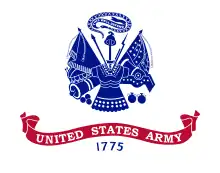 United States Army: Vests, webbing, gear and helmet covers in use for training reserves.
United States Army: Vests, webbing, gear and helmet covers in use for training reserves. United States Air Force: Utilised helmet covers, vests, armor, webbing and gear from U.S. Army to collaborate with former Airman Battle Uniform.
United States Air Force: Utilised helmet covers, vests, armor, webbing and gear from U.S. Army to collaborate with former Airman Battle Uniform. United States Navy: Uniforms and equipment utilised by Navy individual augmentees attached with Army units.
United States Navy: Uniforms and equipment utilised by Navy individual augmentees attached with Army units.
Notes
- Some limited usage from 2004 to 2005 for prototype testing.
- Discontinued on uniforms in 2019, now only remains in service in limited capacities such as on some cold weather equipment, overgear, and older body armor.[1][2]
- Some limited usage from 2004 to 2005 for prototype testing.
- Discontinued on uniforms in 2019, now only remains in service in limited capacities such as on some cold weather equipment, overgear, and older body armor.[1][47]
References
- "Say Goodbye to the Hated Army UCP Uniform". October 2019. Archived from the original on 8 October 2019. Retrieved 8 October 2019.
- image.jpg (JPG). Archived from the original on 1 June 2020.
- "UCP-D:This Is What Happened The Last Time The US Army Created A Pixelated Camo Pattern - Soldier Systems Daily". 10 March 2014. Archived from the original on 16 August 2017. Retrieved 16 August 2017.
- "We should permanently post more U.S. troops abroad. For their own sake". Newsweek. 28 August 2017. Archived from the original on 29 August 2017. Retrieved 28 August 2017.
- "ACU Presentation". ArmyStudyGuide.com. Archived from the original on 7 March 2009. Retrieved 27 June 2009.
- Cramer, Guy, U.S. Army Camouflage Improvement Explained, retrieved 22 October 2022
- Carroll, Ward (9 April 2007). "Defense Tech: Singing the ACU Blues". Defense Tech. Military Advantage, A Monster Company. Archived from the original on 22 July 2012. Retrieved 9 October 2012.
- "Facts: Army Combat Uniform". U.S. Army Training and Doctrine Command Office of the Chief of Public affairs. U.S. Army. 14 June 2004. Archived from the original on 20 August 2012.
- Cramer, Guy (2004). "Dual Texture - U.S. Army Digital Camouflage". United Dynamics Corp. Archived from the original on 11 November 2020. Retrieved 10 July 2009.
- Engber, Daniel (6 July 2012). "Lost in the Wilderness, the Military's Misadventures in Pixelated Camouflage". State. Archived from the original on 27 September 2012. Retrieved 27 September 2012.
- Archived 28 December 2016 at the Wayback Machine
- "New OCP Uniform Fielding Update". Archived from the original on 1 July 2016. Retrieved 23 September 2016.
- Gould, Joe (31 July 2014). "Army Announces Rollout Date for New Camo". Army Times. Gannett. Archived from the original on 1 August 2014.
- "Army Selects New Camouflage Pattern". Military.com. 23 May 2014. Archived from the original on 24 May 2014. Retrieved 23 May 2014.
- Dugas, Anabela; Kramer, F. Matthew (15 December 2004). "Universal Camouflage for the Future Warrior". U.S. Army Natick Soldier Center. Archived from the original on 11 August 2013.
{{cite journal}}: Cite journal requires|journal=(help) - Dugas, A.; Zupkofska, K. J.; DiChiara, A.; Kramer, F. M. (1 December 2004). "Universal Camouflage for the Future Warrior" (PDF). Natick, MA: U.S. Army Research, Development and Engineering Command, Natick Soldier Center. ADA433081. Archived from the original (PDF) on 16 May 2009. Retrieved 27 June 2009.
{{cite journal}}: Cite journal requires|journal=(help) - Cramer, Guy (2004). "New Digital U.S. Army Combat Uniform eliminates Black in pattern". HyperStealth Biotechnology Corp. Archived from the original on 1 September 2009. Retrieved 27 June 2009.
- "Frequently Asked Questions (FAQs) Army Combat Uniform". Program Executive Office Soldier. U.S. Army. 24 February 2012. Archived from the original on 14 February 2013.
- Cox, William (17 September 2009). "UCP Fares Poorly in Army Camo Test". Army Times. Army Times Publishing Company. Retrieved 17 September 2009.
- Maze, Rick (21 June 2009). "Troops in Afghanistan would get new uniforms". Army Times. Army Times Publishing Company. Archived from the original on 4 September 2009. Retrieved 13 August 2009.
- Dickson, Caitlin (14 October 2013). "The Army's $5 Billion New Uniform Already Being Replaced". The Daily Beast. IAC/InterActiveCorp. Archived from the original on 22 January 2014. Retrieved 25 January 2014.
- Cox, Matthew (6 August 2014). "Army Unveils Design Changes for New Camo Uniform". Military.com. Military Advantage, A Monster Company. Archived from the original on 10 August 2014. Retrieved 7 August 2014.
- "What is the CSMR?". California State Military Reserve. Archived from the original on 21 May 2018. Retrieved 20 May 2018.
- Mendie, Ubon (16 September 2010). "New York Guard Members to Begin Wearing Modified ACU". dmna.ny.gov. Archived from the original on 21 May 2018. Retrieved 20 May 2018.
- Larson (2021), p. 127.
- Larson (2021), p. 199.
- Larson (2021), p. 132.
- Larsen (2021), p. 19.
- https://www.fach.mil.cl/soldado/index.html
- "Mike DreisĀ"s - Operator Editor - Gallery 2". Archived from the original on 16 October 2019. Retrieved 20 October 2019.
- Larson (2021), p. 219.
- Larson (2021), p. 394.
- "What are the Camouflage Uniforms of Para SF, MARCOS, and Garud Commandos?". Archived from the original on 6 October 2019. Retrieved 6 October 2019.
- "IAF ground staff get new digital camouflage uniform". 9 October 2022.
- Larsen (2021), p. 243.
- "Kazakhstan - Camopedia". Archived from the original on 18 December 2021. Retrieved 18 December 2021.
- "Archived copy" (PDF). www.mmea.gov.my. Archived from the original (PDF) on 15 August 2018. Retrieved 12 January 2022.
{{cite web}}: CS1 maint: archived copy as title (link) - Larson (2021), p. 166.
- "Specijalne-jedinice.com | Special Anti-terrorist Unit of the Republic of Montenegro". Archived from the original on 22 August 2018. Retrieved 22 August 2018.
- Larson (2021), p. 414.
- Larson (2021), p. 173.
- Larson (2021), p. 309.
- "Specijalne-jedinice.com | Special Anti-terrorist Unit-SAU". Archived from the original on 22 July 2018. Retrieved 22 August 2018.
- "Specijalne-jedinice.com | Gendarmerie of the Republic of Serbia". Archived from the original on 22 July 2018. Retrieved 22 August 2018.
- Larson (2021), p. 461.
- Larson (2021), p. 315.
- https://www.stripes.com/polopoly_fs/1.631982.1591002413!/image/image.jpg_gen/derivatives/landscape_900/image.jpg
Bibliography
- Larson, Eric H. (2021). Camouflage: International Ground Force Patterns, 1946–2017. Barnsley: Pen & Sword. ISBN 9781526739537.
.jpg.webp)